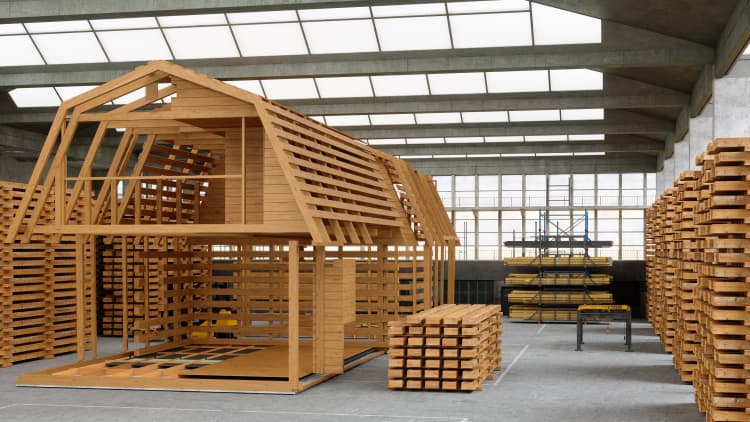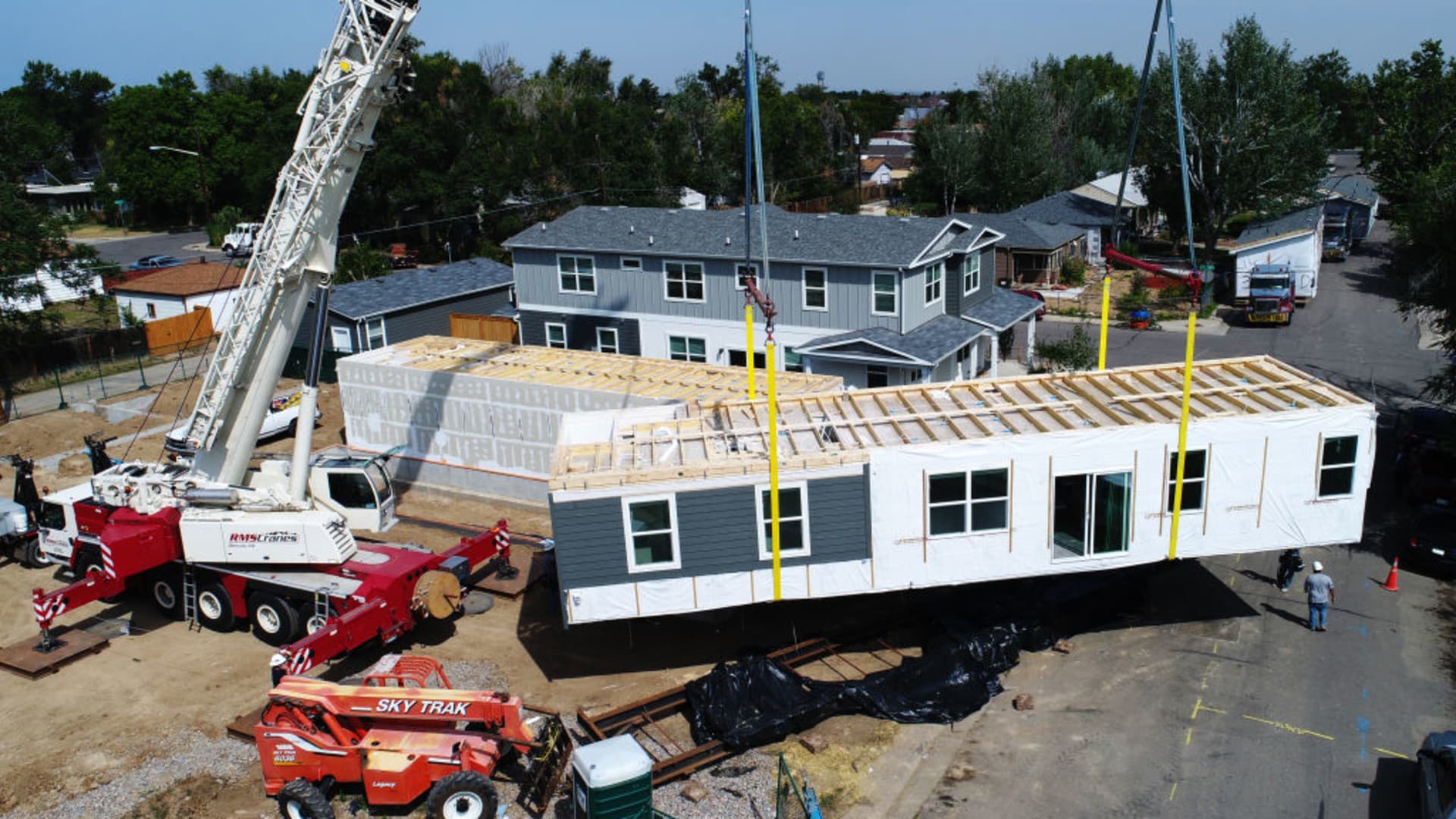A crane taking four 15-foot-wide by 60-foot-long modular home segments and stacking them one on top of the other to make a new duplex in Aurora, Colorado in 2018.
Hyoung Chang | Denver Post | Getty Images
A century ago, a first-time homebuyer might begin their search in a catalog for a kit-built home from Sears and others. In today’s real estate market, the idea rarely registers in house hunting. But with affordability stretched to an extreme and more buyers thinking about sustainability, the modular home — the kit home’s descendent — could be poised for the spotlight.
In the least, U.S. consumers looking to build an efficient and sustainable home should consider going modular. Green construction experts generally agree that modular construction generates less waste and causes less disruption to plants and animals on building sites. And instead of thousands of pieces of lumber, nails, and roofing material that you’d have received with those century-ago kits, modular homes today come in fewer but far larger pieces — assembled in a manufacturer’s facilities, then shipped to the home site, where they’re assembled together. In fact, the modules that make up a modular home can be the size of whole rooms. Typically, it is only the home’s foundation that is actually built on-site.
Modular construction has also attracted interest from affordable housing advocates with mortgage rates, though now on the decline, having reached as high as 8% this year and home prices up in almost every major metro market. The first of up to 2,000 single-family modular homes are being assembled in Chicago’s Southside and will be available for about a $1,000 down payment thanks to a partnership between city and state governments and area non-profits. A smaller affordable modular home project is planned for the Maryland suburbs outside Washington, D.C. Modular dwellings have also been used to combat homelessness in the U.S., Canada, and elsewhere. The issue was raised this week in the op-ed section of the New York Times.
Modular housing can be lower cost
Modular homes have to comply with state and local building codes, and they are financed the same as traditional construction. The difference is price. Modular construction averages $80 to $160 a square foot, which is 10-20% cheaper than traditional construction, according to HomeGuide. That puts the cost of building a typical modular home at $120,000 to $270,000 compared to $155,000 to $416,000 for traditional construction.
The modular building method can save money due to scale. “We have seen offsite construction of repeatable modular units save as much as 25 percent of vertical construction costs,” said Dave Dauphinais, associate partner at the management consultant McKinsey & Company.
Based on these construction costs, down payment and monthly mortgage expenses for a 30-year fixed mortgage at 7.25% interest would be $13,500 and $1749.78/monthly for a high-end modular home, versus $20,800 and $2,695.96/monthly for a traditional top-end $416,000 home, according to Rocket Mortgage.
Several venture capital firms have invested in modular construction, including Khosla Ventures and Y Combinator. One of the larger recent deals was led by Waed Ventures and Bold Capital this September, a $52 million funding round for Mighty Buildings, a startup in the sustainable, modular-home space that uses 3-D printing to automate the construction process.
The net-zero lifestyle goes well with prefab homes
Some modular dwelling manufacturers specifically cater to consumers looking to maximize efficiency or to attempt net-zero living. This includes Deltec Homes, Dvele, and S2A Modular, which all include solar panels in their residential home options.
“Modular home building has come a long way and is worth considering as prefabrication done well can reduce waste and the associated carbon emissions,” said Lisa Carey-Moore, director of buildings at the International Living Future Institute, a nonprofit that promotes regenerative building practices.
Generally, the modular assembly method can use less materials than traditional construction methods – where everything is built on site – because there’s more control over the building process and less chance wood, tile, roofing and other materials will be stolen, damaged, or wasted. It’s also easier to recycle excess materials in a factory setting than on the typical outdoor job site or use excess material from one job on a later one.
More than 15 percent of the materials used to construct a home the traditional way can end up as waste, but waste with modular construction is only about five percent, noted Ryan McEvoy, founder and principal of a sustainable building consulting firm called Gaia Development.
Speed of construction and portability are advantages
Though modular construction companies tout their cost and sustainability — and have attracted notable financial backers such as Bill Gates’ Breakthrough Energy Ventures in the case of Vantem — there can be other advantages. These homes can be constructed relatively quickly in a housing market where inventory is at a historic low. McEvoy noted that a modular home can be move-in ready in eight to 12 months, about half the time needed to build a dwelling the traditional way. And it can be easier to move a modular home to a new location should the need arise, since the structures can be taken apart about as easily as they are put together.
Modular townhomes in Bradenton, Florida, manufactured by Vantem’s Affinity Modular subsidiary.
Vantem
You may have noticed that major retailers such as Costco, Home Depot, Lowe’s and Walmart have begun selling tiny home kits at prices starting under $10,000. These are different than modular homes and not suitable for everyone. At the low end, these structures are basically storage sheds, and marketed as such. Even larger units from these retailers are typically less than 600 square feet – about a third the size of the average American home. Unlike most modular and traditional homes, these little dwellings also lack foundations for extra storage. Instead of basements or crawl spaces, they generally feature metal frames meant to be secured to concrete slabs or mounted on wheeled trailers.
Warren Buffett is in, but modular remains out in the market
Most modular companies are small and do business on a regional basis, but some larger manufacturers exist, such as Champion Home Builders, Kent Homes in Canada, and Clayton Homes, part of Warren Buffett’s sprawling conglomerate Berkshire Hathaway empire.
Overseas, modular homes have been more popular than in the U.S. and have been built quickly. Globally, the modular home market has been estimated at over $100 billion, but for the most part, even with modular homes in the U.S. around for decades, they have yet to catch on with American consumers. The vast majority of U.S. homes are built on-site using traditional methods. By contrast, less than four percent of current housing stock was built using modular techniques, according to a report from McKinsey. That makes modular construction less popular than even mobile homes, which make up 6.3 percent of U.S. housing stock. The research cited multiple factors contributing to the relative rarity. This included a lack of familiarity among contractors as well as the need for financing up front to insure the full cost of construction and modular components.
Some environmental experts are skeptical of the sustainability claims, too.
“Modular and prefab is not necessarily more environmentally friendly than traditional building methods,” said Chris Magwood, a co-founder and director of research at Builders for Climate Action, a Canada-based organization that promotes zero-carbon construction. “It is entirely possible to assemble materials with high climate impact, major toxicity concerns and problematic building science attributes and come up with a bad prefab home. … it’s not so much the prefabrication that makes it better or worse for the environment.”
Indeed, no homebuilding company should be assumed as more sustainable in a market where greenwashing has become all too common. Carey-Moore said it’s critical to evaluate the sustainability credentials of the companies to ensure that building products used are not toxic, sourcing of materials is responsible, and waste is minimized and diverted appropriately.
But to the extent that sustainable building is important to the developer, builder, and buyer, modular solutions often present an attractive alternative to traditional methods,” Dauphinais said. “Modular construction has the potential to be more sustainable.”


